Sony VAIO VGN-BZ26X, VAIO VGN-BZ21VN, VAIO VGN-BZ26M, VAIO VGN-BZ2, VAIO VGN-BZ31XT User Manual
...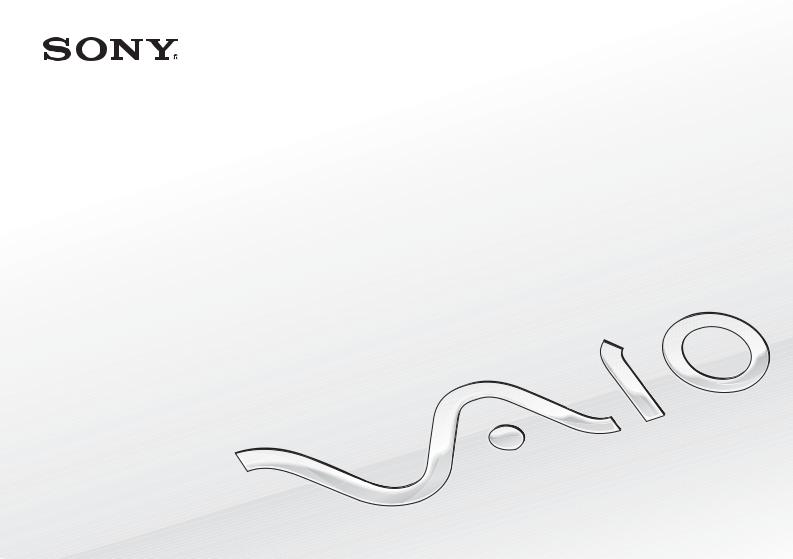
N
User Guide
Personal Computer
VGN-BZ series

n 2 N
Contents |
|
Before Use.......................................................................... |
4 |
Finding More about Your VAIO Computer .................... |
5 |
Ergonomic Considerations ............................................ |
7 |
Getting Started.................................................................... |
9 |
Locating Controls and Ports........................................ |
10 |
About the Indicator Lights ........................................... |
17 |
Connecting a Power Source ....................................... |
18 |
Using the Battery Pack................................................ |
19 |
Shutting Down Your Computer Safely ........................ |
26 |
Updating Your Computer ............................................ |
27 |
Using Your VAIO Computer.............................................. |
28 |
Using the Keyboard..................................................... |
29 |
Using the Touch Pad................................................... |
31 |
Using Special-function Buttons ................................... |
32 |
Using the Built-in Camera ........................................... |
33 |
Using the Optical Disc Drive ....................................... |
35 |
Using the Memory Stick .............................................. |
43 |
Using Other Modules / Memory Cards........................ |
49 |
Using the Internet........................................................ |
56 |
Using the Network (LAN) ............................................ |
58 |
Using the Wireless LAN .............................................. |
60 |
Using the Bluetooth Function ...................................... |
68 |
Using Fingerprint Authentication ................................. |
73 |
Using the TPM............................................................. |
80 |
Using Peripheral Devices.................................................. |
85 |
Connecting a Docking Station ..................................... |
86 |
Connecting External Speakers or Headphones .......... |
94 |
Connecting an External Display .................................. |
95 |
Selecting Display Modes ........................................... |
100 |
Using the Multiple Monitors Function ........................ |
102 |
Connecting an External Microphone ......................... |
104 |
Connecting a USB Device ......................................... |
105 |
Connecting an i.LINK Device..................................... |
107 |
Customizing Your VAIO Computer.................................. |
109 |
Setting the Password................................................. |
110 |
Using the VAIO Control Center ................................. |
122 |
Using the Power Saving Modes ................................ |
123 |
Using the VAIO Power Management......................... |
128 |
Protecting Data from Unauthorized Use.................... |
130 |
Protecting the Hard Disk............................................ |
133 |
Configuring Your Modem........................................... |
134 |
Upgrading Your VAIO Computer..................................... |
136 |
Adding and Removing Memory ................................. |
137 |

n 3 N
Precautions..................................................................... |
143 |
Handling the LCD Screen ......................................... |
144 |
Using the Power Source ........................................... |
145 |
Handling Your Computer........................................... |
146 |
Handling the Built-in Camera .................................... |
149 |
Handling Discs .......................................................... |
150 |
Using the Battery Pack.............................................. |
151 |
Using Headphones.................................................... |
152 |
Handling the Memory Stick ....................................... |
153 |
Handling the Built-in Storage Device ........................ |
154 |
Using Fingerprint Authentication ............................... |
155 |
Using the TPM .......................................................... |
156 |
Troubleshooting .............................................................. |
158 |
Computer .................................................................. |
160 |
System Security ........................................................ |
166 |
Battery....................................................................... |
167 |
Built-in Camera ......................................................... |
169 |
Internet ...................................................................... |
171 |
Networking ................................................................ |
173 |
Bluetooth Technology ............................................... |
178 |
Optical Discs ............................................................. |
182 |
Display ...................................................................... |
186 |
Printing ...................................................................... |
190 |
Microphone ............................................................... |
192 |
Speakers ................................................................... |
193 |
Touch Pad ................................................................. |
194 |
Keyboard ................................................................... |
195 |
Floppy Disks .............................................................. |
196 |
PC Cards ................................................................... |
197 |
Audio/Video ............................................................... |
199 |
Memory Stick............................................................. |
201 |
Peripherals ................................................................ |
202 |
Docking Station ......................................................... |
204 |
Trademarks ..................................................................... |
205 |
Notice .............................................................................. |
207 |

Before Use >
n 4 N
Before Use
Congratulations on your purchase of this Sony VAIO® computer, and welcome to the on-screen User Guide. Sony has combined leading-edge technology in audio, video, computing, and communications to provide state-of-the-art personal computing experience.
!
External views illustrated in this manual may look slightly different from those of your computer.
Information in the supplied manuals including this User Guide is intended for users of the VAIO computers with the Microsoft® Windows Vista® 32-bit operating system. You may find differences in the information when your computer comes preinstalled with the 64-bit operating system.
 How to find specifications
How to find specifications
Some features, options, and supplied items may not be available on your computer.
To find out about the configuration of your computer, visit the VAIO Link web site at http://www.vaio-link.com.

Before Use > |
|
Finding More about Your VAIO Computer |
n 5 N |
Finding More about Your VAIO Computer
This section provides support information about your VAIO computer.
1. Printed Documentation
Quick Start Guide — An overview of components connection, set-up information, etc.
Troubleshooting and Recovery Guide
Regulations, Guarantee, EULA and Service Support
2. On-screen Documentation
User Guide (This manual) — Features of your computer and information about solving common problems. To view this on-screen guide:
1 Double-click the VAIO User Guide icon on the desktop.
2 Open the folder for your language.
3 Select the guide you want to read.
You can manually browse to the user guides by going to Computer > VAIO (C:) (your C drive) > Documentation > Documentation and opening the folder for your language.
Windows Help and Support — A comprehensive resource for practical advice, tutorials, and demonstrations to help you learn to use your computer.
To access Windows Help and Support, click Start  and Help and Support, or press and hold the Microsoft Windows key and press the F1 key.
and Help and Support, or press and hold the Microsoft Windows key and press the F1 key.

Before Use > |
|
Finding More about Your VAIO Computer |
n 6 N |
3. Support Web Sites
If you have any problem with the computer, you can visit the VAIO-Link web site at http://www.vaio-link.com for troubleshooting.
Before contacting VAIO-Link by telephone, try to solve the problem by reading the supplied documentation and visiting other Sony web sites.
For more about VAIO and becoming part of the growing VAIO community, visit the web site at http://www.club-vaio.com.
For online purchases, visit the web site at http://www.sonystyle-europe.com.
For other Sony products, visit the web site at http://www.sony.net.
When you contact VAIO-Link by telephone, have the serial number of your VAIO computer ready at hand. The serial number is located on the bottom, the back panel, or inside the battery compartment of your VAIO computer.

Before Use > |
|
Ergonomic Considerations |
n 7 N |
Ergonomic Considerations
You will be using your computer as a portable device in a variety of environments. Whenever possible, you should attempt to take account of the following ergonomic considerations for both stationary and portable environments:
Position of your computer – Place the computer directly in front of you (1). Keep your forearms horizontal (2), with your wrists in a neutral, comfortable position (3) while using the keyboard or the pointing device. Let your upper arms hang naturally at your sides. Take frequent breaks while using your computer. Excessive use of the computer may strain eyes, muscles, or tendons.
Furniture and posture – Sit in a chair with good back support. Adjust the level of the chair so your feet are flat on the floor. A footrest may make you more comfortable. Sit in a relaxed, upright posture and avoid slouching forward or leaning far backwards.

Before Use > |
|
Ergonomic Considerations |
n 8 N |
Viewing angle of the computer's display – Use the display's tilting feature to find the best position. You can reduce eye strain and muscle fatigue by adjusting the tilt of the display to the proper position. Adjust the brightness level of the display as well.
Lighting – Choose a location where windows and lights do not cause glare and reflection on the display. Use indirect lighting to avoid bright spots on the display. Proper lighting adds to your comfort and work efficiency.
Positioning an external display – When using an external display, set the display at a comfortable viewing distance. Make sure the display screen is at eye level or slightly lower when you are sitting in front of the monitor.

Getting Started >
n 9 N
Getting Started
This section describes how to get started using your VAIO computer.
Locating Controls and Ports (page 10)
About the Indicator Lights (page 17)
Connecting a Power Source (page 18)
Using the Battery Pack (page 19)
Shutting Down Your Computer Safely (page 26)
Updating Your Computer (page 27)

Getting Started > |
|
Locating Controls and Ports |
n 10 N |
Locating Controls and Ports
Take a moment to identify the controls and ports shown on the following pages.
!
The appearance of your computer may be different from those illustrated in this manual due to variations in specifications. It may also vary in some countries or areas.
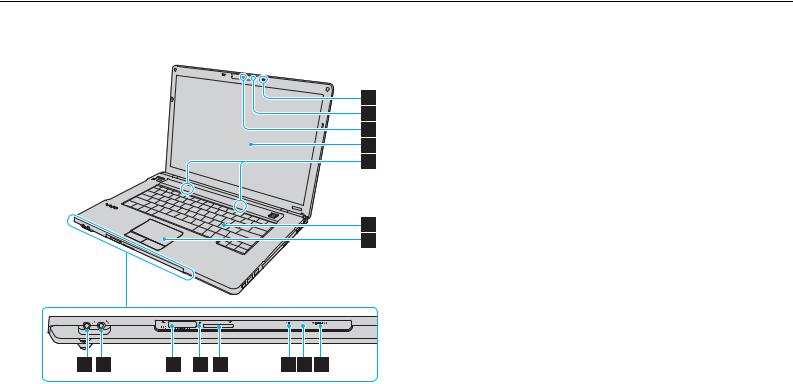
Getting Started > |
|
Locating Controls and Ports |
n 11 N |
Front
A Built-in microphone (monaural)*1
B Built-in MOTION EYE camera indicator*1 (page 17)
C Built-in MOTION EYE camera*1 (page 33)
D LCD screen (page 144)
E Built-in speakers (stereo)
F Keyboard (page 29)
G Touch pad (page 31)
H Headphones jack (page 94)
I Microphone jack (page 104)
J Memory Stick slot*2 (page 43)
K Media Access indicator (page 17)
L SD memory card slot (page 52)
M Charge indicator (page 17)
N Disc drive indicator (page 17)
O WIRELESS indicator (page 17)
*1 |
On selected models only. |
*2 |
Your computer supports both the standard-size Memory Stick and the Duo- |
|
size Memory Stick. |

Getting Started > |
|
Locating Controls and Ports |
n 12 N |
A WIRELESS switch (page 60), (page 68)
B Muting button (page 32)
C S1 button (page 32)
D Num lock indicator (page 17)
E Caps lock indicator (page 17)
F Scroll lock indicator (page 17)
G Fingerprint sensor* (page 73)
* On selected models only.

Getting Started > |
|
Locating Controls and Ports |
n 13 N |
Back
A Battery connector (page 19)

Getting Started > |
|
Locating Controls and Ports |
n 14 N |
Right
A i.LINK 4-pin (S400) port (page 107)
B Hi-Speed USB (USB 2.0) ports* (page 105)
C Optical disc drive (page 35)
D Optical disc drive indicator (page 17)
E Drive eject button (page 35)
F Manual eject hole (page 182)
G Network (Ethernet) port (page 58)
H Modem port (page 56)
I Power button/Power indicator (page 17)
* Support high-/full-/low- speeds.

Getting Started > |
|
Locating Controls and Ports |
n 15 N |
Left
A DC IN port (page 18)
B Security slot
C Air vent
D Monitor port*1 (page 96)
E Hi-Speed USB (USB 2.0) port*2 (page 105)
F PC Card slot (page 49)
G PC Card release button (page 51)
*1 Not accessible when your computer is attached to the docking station.
*2 Supports high-/full-/low- speeds.

Getting Started > |
|
Locating Controls and Ports |
n 16 N |
Bottom
A Memory module compartment cover (page 137)
B Air vents
C Docking station connector (page 88)

Getting Started > |
|
About the Indicator Lights |
n 17 N |
About the Indicator Lights
Your computer is equipped with the following indicator lights:
Indicator |
Functions |
|
|
|
|
Power 1 |
Illuminates in green when the computer is on, blinks slowly in orange while the computer is in Sleep mode, and |
|
|
turns off when the computer is off or in Hibernate mode. |
|
|
|
|
Charge |
Illuminates while the battery pack is charging. See Charging the Battery Pack (page 22) for more information. |
|
|
|
|
Media Access |
Illuminates while data is being read from or written to a memory card, such as the Memory Stick and the SD |
|
|
memory card. (Do not place the computer into Sleep mode or turn it off when this indicator is lit.) When the |
|
|
indicator is unlit, the memory card is not in use. |
|
|
|
|
Built-in MOTION EYE camera* |
Illuminates while the built-in camera is in use. |
|
|
|
|
Optical disc drive |
Illuminates while the drive is reading or writing data. When the indicator is unlit, the optical disc media is not in |
|
|
use. |
|
|
|
|
Disc drive |
Illuminates while the built-in storage device or the optical disc drive is running to read or write data. |
|
Do not place the computer into Sleep mode or turn it off when this indicator is lit. |
||
|
||
|
|
|
Num lock |
Press the Num Lk key to activate the numeric keypad. Press it a second time to deactivate the numeric keypad. |
|
The numeric keypad is not active when the indicator is unlit. |
||
|
||
|
|
|
Caps lock |
Press the Caps Lock key to type letters in uppercase. Letters appear in lowercase if you press the Shift key |
|
while the indicator is lit. Press the key a second time to turn off the indicator. Normal typing resumes when the |
||
|
||
|
Caps lock indicator is unlit. |
|
|
|
|
Scroll lock |
Press the Fn+Scr Lk keys to change how you scroll the display. Normal scrolling resumes when the Scroll lock |
|
indicator is unlit. The Scr Lk key functions differently depending on the program you are using and does not |
||
|
||
|
work with all programs. |
|
|
|
|
WIRELESS |
Illuminates when one or more wireless options are enabled. |
|
|
|
*On selected models only.
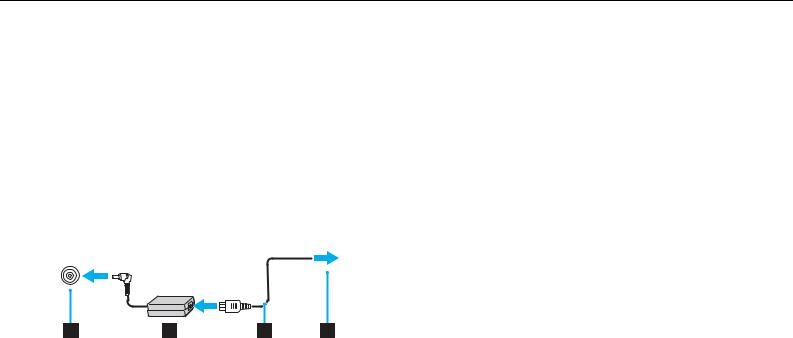
Getting Started > |
|
Connecting a Power Source |
n 18 N |
Connecting a Power Source
You can use either an AC adapter or a rechargeable battery pack for supplying power to your computer.
Using the AC Adapter
Use only the supplied AC adapter for your computer.
To use the AC adapter
1Plug one end of the power cord (1) into the AC adapter (3).
2Plug the other end of the power cord into an AC outlet (2).
3Plug the cable connected to the AC adapter (3) into the DC IN port (4) on the computer or on the optional docking station.
To disconnect your computer completely from AC power, unplug the AC adapter. Make sure that the AC outlet is easily accessible.
If you do not intend to use your computer for a long period of time, place the computer into Hibernate mode. See Using Hibernate Mode (page 126).
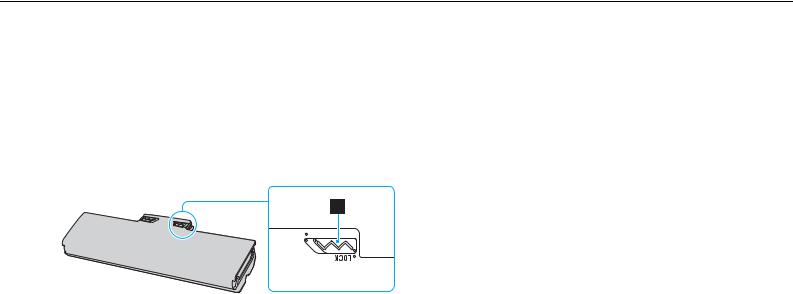
Getting Started > |
|
Using the Battery Pack |
n 19 N |
Using the Battery Pack
The battery pack supplied with your computer is not fully charged at the time of delivery.
Installing the Battery Pack
To install the battery pack
1Turn off the computer and close the LCD screen lid.
2Slide the battery LOCK switch (1) inward.
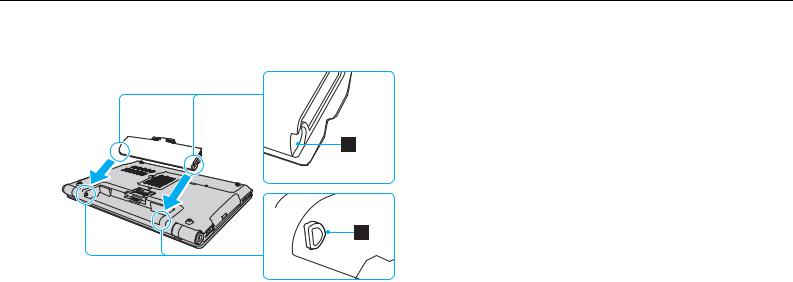
Getting Started > |
|
Using the Battery Pack |
n 20 N |
3Slide the battery pack diagonally into the battery compartment until the projections (2) on either side of the battery compartment fit into the U-shaped cuts (3) on either side of the battery pack.

Getting Started > |
|
Using the Battery Pack |
n 21 N |
4 Push the battery pack down into the compartment until it clicks into place.
5 Slide the battery LOCK switch outward to secure the battery pack on the computer.
When your computer is directly connected to AC power and has a battery pack installed, it uses power from the AC outlet.
!
Certain rechargeable batteries do not meet Sony quality and safety standards. For safety reasons this computer only functions with genuine Sony battery packs designed for this model. If an unauthorized battery pack is installed, the battery will not be charged and the computer will not function.

Getting Started > |
|
Using the Battery Pack |
n 22 N |
Charging the Battery Pack
The battery pack supplied with your computer is not fully charged at the time of delivery.
To charge the battery pack
1Install the battery pack.
2Connect the computer to a power source with the AC adapter.
The charge indicator light turns on while the battery pack is charging. When the battery pack charges close to the maximum charge level you selected with the battery charge functions, the charge indicator turns off. To select your desired maximum charge level, see Using the Battery Charge Functions (page 24).
Charge indicator status |
Meaning |
|
|
Lit in orange |
The battery pack is charging. |
|
|
Blinks along with the green power |
The battery pack is running out of power. (Normal |
indicator |
mode) |
|
|
Blinks along with the orange power |
The battery pack is running out of power. (Sleep mode) |
indicator |
|
|
|
Blinks fast in orange |
A battery error has occurred due to a failed battery |
|
pack or an unlocked battery pack. |
|
|
!
Charge the battery pack as described in this manual from your first battery charge.

Getting Started > |
|
Using the Battery Pack |
n 23 N |
Keep the battery pack in your computer while it is directly connected to AC power. The battery pack continues to charge while you are using the computer.
If the battery charge level falls below 10%, you should either connect the AC adapter to recharge the battery pack or shut down your computer and install a fully charged battery pack.
Your computer is supplied with a lithium ion battery pack and can be recharged any time. Charging a partially discharged battery pack does not affect the life of battery.
While some software applications or peripheral devices are in use, your computer may not enter Hibernate mode even when the remaining battery life is short. To avoid loss of data when using battery power, you should save your data frequently and manually activate a power management mode, such as Sleep or Hibernate.
If the battery pack wears out when the computer enters Sleep mode, you will lose all unsaved data. Going back to the previous work state is impossible. To avoid loss of data, you should save your data frequently.
When your computer is directly connected to AC power and has a battery pack installed, it uses power from the AC outlet.

Getting Started > |
|
Using the Battery Pack |
n 24 N |
Using the Battery Charge Functions
You can customize the current battery charging method using the Battery Charge Functions. To make the life of battery longer, enable the battery care function.
To enable the battery care function
1Click Start, All Programs, and VAIO Control Center.
2Click Power Management and then Battery Charge Functions.
3Click Advanced.
4Click to select the Enable Battery Care Function check box.
5Select the desired maximum charge level.
6Click OK.
To check the battery charge capacity
Follow steps 1 to 3 in To enable the battery care function above and check detailed information. If the battery charge capacity is low, replace the battery pack with a new genuine Sony battery pack.
Using the Battery Life Conserving Wallpaper
You can conserve your battery life just by setting the specific wallpaper as your desktop background.
To set the battery life conserving wallpaper
1Click Start, All Programs, and VAIO Control Center.
2Click Display and then Long Battery Life Wallpaper Setting.
3Click Set Long Battery Life Wallpaper. At the confirmation prompt, click OK.

Getting Started > |
|
Using the Battery Pack |
n 25 N |
Removing the Battery Pack
!
You may lose data if you remove the battery pack while your computer is on and not connected to the AC adapter or if you remove the battery pack while the computer is in Sleep mode.
To remove the battery pack
1Turn off the computer and close the LCD screen lid.
2Slide the battery LOCK switch (1) inward.
3Slide and hold the battery RELEASE latch (2) inward, put your fingertip underneath the tab (3) on the battery pack, and lift the battery pack in the direction of the arrow, and then slide it away from the computer.

Getting Started > |
|
Shutting Down Your Computer Safely |
n 26 N |
Shutting Down Your Computer Safely
To avoid losing unsaved data, be sure to shut down your computer properly, as described below.
To shut down your computer
1Turn off any peripherals connected to the computer.
2Click Start, the arrow  next to the Lock button, and then Shut Down.
next to the Lock button, and then Shut Down.
3Respond to any prompts warning you to save documents or to consider other users and wait for the computer to turn off automatically.
The power indicator light turns off.

Getting Started > |
|
Updating Your Computer |
n 27 N |
Updating Your Computer
Be sure to install the latest updates on your computer with the following software applications so that the computer can run more efficiently.
Windows Update
Click Start, All Programs, and Windows Update and then follow the on-screen instructions.
VAIO Update 4
Click Start, All Programs, VAIO Update 4, and VAIO Update Options and then follow the on-screen instructions.
!
Your computer must be connected to the Internet to download the updates.

Using Your VAIO Computer >
n 28 N
Using Your VAIO Computer
This section describes how to get the most out of using your VAIO computer.
Using the Keyboard (page 29)
Using the Touch Pad (page 31)
Using Special-function Buttons (page 32)
Using the Built-in Camera (page 33)
Using the Optical Disc Drive (page 35)
Using the Memory Stick (page 43)
Using Other Modules / Memory Cards (page 49)
Using the Internet (page 56)
Using the Network (LAN) (page 58)
Using the Wireless LAN (page 60)
Using the Bluetooth Function (page 68)
Using Fingerprint Authentication (page 73)
Using the TPM (page 80)

Using Your VAIO Computer > |
|
Using the Keyboard |
n 29 N |
Using the Keyboard
Your keyboard has additional keys that perform model-specific tasks.
Combinations and Functions with the Fn Key
Some keyboard functions can be used only after the operating system is finished launching.
Combinations/Feature |
Functions |
|||
|
|
|
||
Fn + 2 (F3/F4): speaker volume |
Changes the built-in speaker volume level. |
|||
|
|
|
|
To increase the volume, keep pressing the Fn+F4 keys or press the Fn+F4 keys and then the |
|
|
|
|
M or , key. |
|
|
|
|
To decrease the volume, keep pressing the Fn+F3 keys or press the Fn+F3 keys and then the |
|
|
|
|
m or < key. |
|
|
|
||
Fn + 8 (F5/F6): brightness control |
Changes the LCD brightness of your computer screen. |
|||
|
|
|
|
To increase lighting intensity, keep pressing the Fn+F6 keys or press the Fn+F6 keys and then |
|
|
|
|
the M or , key. |
|
|
|
|
To decrease lighting intensity, keep pressing the Fn+F5 keys or press the Fn+F5 keys and then |
|
|
|
|
the m or < key. |
|
|
|
|
|
Fn + |
|
/T (F7): display output |
Toggles among your computer screen, an external display, and simultaneous output to both. |
|
|
|
|||
|
|
|
|
|
Fn + |
|
/ |
(F9/F10): zoom |
Changes the size of an image or a document displayed on some software. |
|
To make the view look smaller and further away (zoom out), press the Fn+F9 keys. |
|||
|
|
|
|
|
|
|
|
|
To make the view look bigger and closer (zoom in), press the Fn+F10 keys. |
|
|
|
|
See the help file included with the VAIO Control Center for more information. |
|
|
|
|
|

Using Your VAIO Computer > |
|
|
||
Using the Keyboard |
n 30 N |
|||
|
|
|
|
|
|
|
|
|
|
|
Combinations/Feature |
Functions |
|
|
|
|
|
|
|
|
Fn + |
(F12): hibernate |
Provides the lowest level of power consumption. When you execute this command, the states |
|
|
of the system and the connected peripheral devices are saved to the built-in storage device and |
|
||
|
|
|
|
|
|
|
|
the system power is turned off. To return the system to its original state, use the power button |
|
|
|
|
to turn on the power. |
|
|
|
|
For details on power management, see Using the Power Saving Modes (page 123). |
|
|
|
|
|
|
